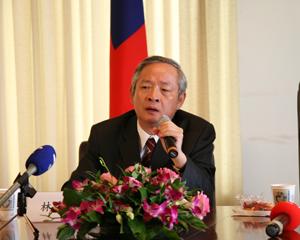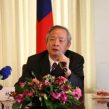
Taiwan’s Military Shores Up Indigenous Defense Capabilities
Publication: China Brief Volume: 10 Issue: 18
By:

While Taiwan is stepping up calls for the United States to sell the island new F-16 jets and diesel submarines, there are signs that the Taiwanese military has been shoring up the island’s indigenously developed military capabilities. Recent pronouncements by a prominent Taiwanese legislator from the ruling Kuomintang (KMT) party revealed that the Hsiung Feng "Brave Wind" 2E surface-to-surface cruise missile system developed by the Chunghsan Institute of Science and Technology may be deployed around the end of 2010. According to KMT Legislator Lin Yu-fang, who chairs the Legislative Yuan’s National Defense Committee, the Wan Chien "Ten Thousand Swords" cluster bomb has also passed the air force’s "initial operational testing" and will eventually be employed to augment the combat capabilities of its Indigenous Defensive Fighter (IDF) (China Times, August 30; September 8; Liberty Times, September 8).
These developments dovetail a recent U.S. announcement that Washington will sell new radar upgrades for Taiwan’s IDF, which follows in line with Taiwanese efforts to upgrade its F-CK-1 A/B IDF, or Ching-kuo, into C/D "joint strike fighters" (Defense News, August 25). When equipped with the new Wan Chien "Ten Thousand Swords" cluster bomb, the Taiwanese Air Force would reportedly be able to strike China’s military installations from more than 200 kilometers away (Liberty Times, September 8).
According to a Taiwanese military source cited by Defense News, the radar sale marks "phase two of the IDF’s F-CK-1C/D Hsiang Sheng upgrade program" (Defense News, August 25). The release of the radar after a temporary hold might also signal that Washington has reevaluated the target and approach of assisting Taiwan’s defense needs. If the radar sales were part of a larger coordinated package, the framework would appear to be more focused on bolstering "industrial cooperation" between the two sides, which could help develop Taiwan’s defense industrial capacity. Given strict controls, the extent of Taiwan’s military modernization to meet China’s growing military threat has been severely limited by what it can develop and manufacture domestically and more importantly, what the United States agrees to sell—which is becoming increasingly complicated.
Yet, there are conflicting signals emanating from Taiwan’s military establishment. In the Ministry of Defense 2011 national defense budget, which was submitted to the Legislative Yuan on August 31, the budget of NT$297.2 billion ($9.27 billion) is NT$200 million less than that of last year. This figure accounts for 16.6 percent of the nation’s entire budget, which is less than three percent of GDP (2.73 percent), and the lowest in nearly five years. More importantly, of the total amount, NT$272.7 billion was listed as open funds, while only NT$24.5 billion ($785.5 million) was budgeted for classified spending, which marks a decrease of nearly 40 percent (Central News Agency, August 31; Liberty Times, August 31). Yet, according to KMT Legislator Lin, while some weapons purchases originally scheduled for next year may be shelved or canceled, military production and research and development of counterattack or defensive weapons has remained steady (Central News Agency, August 31).
In spite of a thaw in bilateral ties since Taiwanese President Ma Ying-jeou assumed office in 2008, China’s military modernization has continued unabated and is tilting the military balance in Beijing’s favor. This trend is clearly reflected in both the 2010 U.S. Department of Defense’s annual report on the Chinese military as well as the Taiwanese Ministry of Defense’s report on China’s military power. China’s systematic development of sophisticated ballistic missiles in recent years has substantially expanded the inventory of its Second Artillery Corps and widened its operational reach. Of particular concern is the longer-range variant of the DF-21, which could be deployed into further hinterland and beyond the scope of Taiwan’s defenses.
According to a senior Taiwanese intelligence official cited by the Liberty Times, China is planning to increase the existing estimated 1,500 missiles aimed at Taiwan to at least 1,800 (ETaiwannews, August 9). The announcement to deploy Hsiung Feng 2E missiles also comes in the wake of Taiwanese intelligence indications that China has deployed eight battalions of advanced S-300PMU2 long-range surface-to-air missiles in Fuqing county in Fujian province’s Longtian Military Airbase (See "China-Taiwan Up Missile Ante," China Brief, April 1).
Taiwan’s Deputy Defense Minister Andrew Yang said in a report that the island is upgrading two missile batteries and adding four, anchored by Patriot III missiles from the United States. The defense shield is reportedly due in 2015 and will enable Taiwan to track incoming Chinese short-range missiles. The NT$40 billion ($1.25 billion) early-warning radar system can also track inbound ballistic and cruise missiles (Reuters, September 8).
Against the backdrop of China’s growing conventional threat toward Taiwan, the initiatives undertaken by Taipei and Washington to shore up Taiwan’s indigenous defense capabilities may reflect a deeper transformation in the U.S.-Taiwan defense relationship. As China continues its acquisition, development and deployment of new ballistic and cruise missile systems, it is increasingly putting U.S. assets in the region at risk. The destabilizing effects posed by China’s increasing military assertiveness are also causing growing anxiety among its neighbors and strengthening U.S. ties with regional partners.





